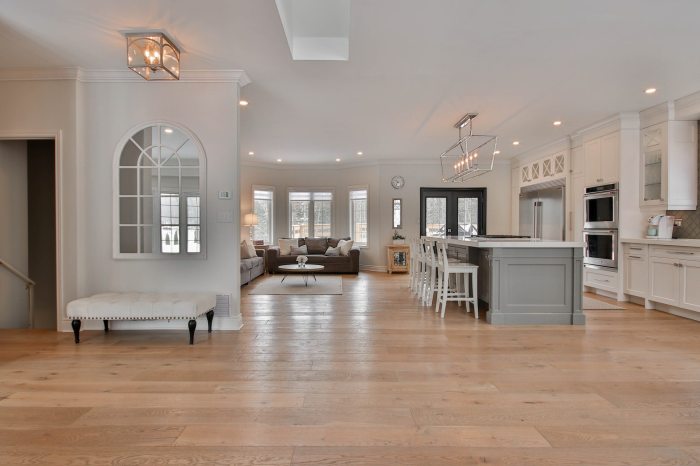When it comes to home remodeling, choosing the right flooring can make all the difference. From hardwood to vinyl, each type of flooring has its own unique characteristics that can transform your space. Let's dive into the world of flooring options and discover the best choices for your home remodel.
Types of flooring materials
When it comes to home remodeling, choosing the right type of flooring material is crucial as it can greatly impact the overall look and feel of your space. Let's explore some of the most popular flooring materials used in modern home remodels.
Hardwood
Hardwood flooring is known for its timeless appeal and natural beauty. It adds warmth and elegance to any room. However, hardwood floors can be expensive to install and are prone to scratches and water damage. Regular maintenance, such as refinishing, is necessary to keep them looking their best.
Laminate
Laminate flooring is a cost-effective alternative to hardwood that mimics the look of wood. It is durable, scratch-resistant, and easy to clean. However, laminate floors can be prone to water damage and may not add as much value to a home as hardwood.
Vinyl
Vinyl flooring is a versatile and budget-friendly option that comes in a variety of styles, including wood and tile looks. It is water-resistant, durable, and easy to maintain. However, vinyl may not have the same luxurious feel as hardwood or tile.
Tile
Tile flooring, such as ceramic or porcelain, is popular for its durability and variety of design options. It is water-resistant and easy to clean, making it perfect for high-traffic areas like kitchens and bathrooms. However, tile can be cold underfoot and may require professional installation.
Carpet
Carpet is known for its comfort and warmth, making it a popular choice for bedrooms and living rooms. It is available in a wide range of colors and textures. However, carpet can stain easily and may trap allergens, requiring regular cleaning and maintenance.
Considerations for choosing the best flooring
When selecting the best flooring for a home remodel, several factors need to be taken into account to ensure the choice aligns with your needs and preferences. Factors such as budget, lifestyle, design preferences, and location play a crucial role in determining the most suitable flooring option for your space.
Budget-friendly Flooring Options
- Consider affordable options like laminate or vinyl flooring, which mimic the look of more expensive materials like hardwood or stone at a fraction of the cost.
- Look for promotions or discounts from manufacturers to make the most of your budget while still achieving the desired aesthetic.
- Remember to account for installation costs when budgeting for your flooring project.
Matching Flooring with Room Functionality and Aesthetics
- Choose durable and water-resistant flooring like tile or luxury vinyl for high-traffic areas such as the kitchen or bathroom.
- Opt for cozy and comfortable flooring options like carpet or hardwood for bedrooms and living rooms to create a warm and inviting atmosphere.
- Consider the overall design and color scheme of each room to ensure the flooring complements the existing decor and enhances the ambiance.
Impact of Flooring on Ambiance
- The type of flooring you choose can significantly impact the overall ambiance of a space, influencing how light is reflected, sound is absorbed, and warmth is retained.
- Light-colored flooring can make a room appear larger and brighter, while dark flooring adds a sense of coziness and sophistication.
- The texture and pattern of the flooring can also contribute to the visual interest and style of a room, enhancing the overall design aesthetic.
Sustainability and eco-friendly flooring options

When it comes to home remodels, choosing sustainable and eco-friendly flooring options can make a significant impact on reducing your environmental footprint. These options not only contribute to a healthier planet but also create a unique and stylish look for your home.
Bamboo Flooring
Bamboo flooring is a popular choice for eco-conscious homeowners due to its rapid growth and renewability
Cork Flooring
Cork flooring is another eco-friendly option that comes from the bark of cork oak trees. It is a renewable resource that can be harvested without harming the trees, making it a sustainable choice for flooring. Cork flooring is known for its natural warmth and comfort underfoot, as well as its sound-absorbing properties.
It is available in a range of colors and patterns to suit any interior design.
Reclaimed Wood Flooring
Reclaimed wood flooring is a unique and environmentally friendly option that involves using wood from old buildings, barns, or other structures. By repurposing this wood, you not only reduce waste but also add character and history to your home. Reclaimed wood flooring is durable, stylish, and adds a rustic charm to any space.
Recycled Materials Flooring
Using recycled materials such as glass, rubber, or plastic to create flooring is a creative way to reduce environmental impact. These materials can be transformed into stylish and innovative flooring options that are both durable and eco-friendly. Recycled materials flooring offers a unique look and texture, making a statement in any room.
Benefits of Sustainable Flooring
- Reduces demand for new raw materials
- Minimizes environmental impact
- Promotes healthier indoor air quality
- Adds value to your home
- Provides a unique and stylish look
Installation and maintenance tips
When it comes to installing and maintaining different types of flooring, there are specific steps and practices to follow to ensure longevity and aesthetics in your home.
Preparation of Subfloor
Before installing any type of flooring, it is crucial to prepare the subfloor properly. This involves ensuring that the subfloor is clean, dry, level, and free of any debris. You may need to make repairs or adjustments to the subfloor to create a smooth and stable surface for the new flooring.
Laying the Flooring
When laying the flooring, make sure to follow the manufacturer's instructions carefully. Whether you are installing hardwood, laminate, tile, or carpet, each type of flooring has specific requirements for installation. Take your time to ensure that each piece fits snugly and securely in place.
Finishing Touches
After installing the flooring, it is important to complete the finishing touches to enhance the overall look and durability. This may include adding baseboards, trim, or transitions between different flooring types. These details can make a significant difference in the final appearance of your floors.
Maintenance Practices
Regular maintenance is key to preserving the beauty and condition of your flooring. Different types of flooring require specific care routines, such as sweeping, vacuuming, mopping, or professional cleaning. Avoid using harsh chemicals or abrasive tools that can damage the flooring surface.
Avoiding Common Pitfalls
During the installation and maintenance process, it is essential to be aware of common pitfalls that can affect the quality and longevity of your flooring. These may include improper installation techniques, neglecting maintenance tasks, or using the wrong cleaning products.
By staying informed and following best practices, you can avoid these pitfalls and enjoy your beautiful floors for years to come.
Final Summary
In conclusion, selecting the best flooring for your home remodel is a crucial decision that impacts both the aesthetics and functionality of your space. By considering factors like durability, design preferences, and sustainability, you can create a space that truly reflects your style and values.
Upgrade your home with the perfect flooring choice today.
FAQ
What is the most durable flooring option?
Hardwood flooring is known for its durability and timeless appeal, making it a popular choice for many homeowners.
How can I choose the right flooring for a high-traffic area?
Opt for laminate or vinyl flooring, as they are more resistant to wear and tear compared to other options like carpet.
Are eco-friendly flooring options more expensive?
While some eco-friendly materials may have a higher upfront cost, they often prove to be more cost-effective in the long run due to their durability and sustainability.














